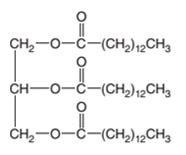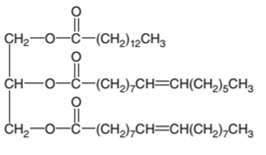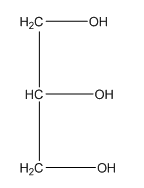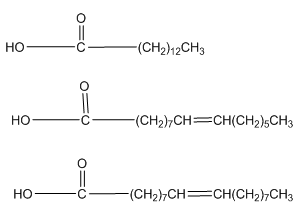
General, Organic, & Biological Chemistry
3rd Edition
ISBN: 9780073511245
Author: Janice Gorzynski Smith Dr.
Publisher: McGraw-Hill Education
expand_more
expand_more
format_list_bulleted
Concept explainers
Question
Chapter 19.4, Problem 19.13P
(a)
Interpretation Introduction
Interpretation:
The products formed from hydrolysis of the following triacylglycerol should be drawn:

Concept Introduction:
Triacylglycerols also known as triglycerides, are formed by the combination of glycerol and three molecules of fatty acids. The final triglyceride structure contains three ester parts in it.
(b)
Interpretation Introduction
Interpretation: The products formed from hydrolysis of the following triacylglycerol should be drawn:

Concept Introduction:
Triacylglycerols also known as triglycerides, are formed by the combination of glycerol and three molecules of fatty acids. The final triglyceride structure contains three ester parts in it.


Expert Solution & Answer
Want to see the full answer?
Check out a sample textbook solution
Students have asked these similar questions
Draw the most likely mechanism for the following:
Calculate the number of moles of HI that are at equilibrium with 4.9 mol of H2 and 4.9 mol of I2 in a 5.00-L flask at 448 °C. (those are the equilibrium values)
Ε.
HO
HO
Chapter 19 Solutions
General, Organic, & Biological Chemistry
Ch. 19.1 - Prob. 19.1PCh. 19.1 - Prob. 19.2PCh. 19.2 - Prob. 19.3PCh. 19.2 - Prob. 19.4PCh. 19.2 - Prob. 19.5PCh. 19.3 - Prob. 19.6PCh. 19.3 - Prob. 19.7PCh. 19.3 - Prob. 19.8PCh. 19.3 - Prob. 19.9PCh. 19.4 - Prob. 19.10P
Ch. 19.4 - Prob. 19.11PCh. 19.4 - Prob. 19.12PCh. 19.4 - Prob. 19.13PCh. 19.5 - Review Section 5.2 on balancing chemical...Ch. 19.5 - Prob. 19.15PCh. 19.6 - Prob. 19.16PCh. 19.6 - Prob. 19.17PCh. 19.7 - Prob. 19.18PCh. 19.7 - Prob. 19.19PCh. 19.7 - Prob. 19.20PCh. 19.8 - Prob. 19.21PCh. 19.8 - Prob. 19.22PCh. 19.8 - Identify the functional groups in (a)...Ch. 19.9 - Compare the structures of estrone and...Ch. 19.9 - Prob. 19.25PCh. 19.10 - Prob. 19.26PCh. 19.11 - Prob. 19.27PCh. 19.11 - Prob. 19.28PCh. 19 - Label each compound as a hydrolyzable or...Ch. 19 - Label each compound as a hydrolyzable or...Ch. 19 - Prob. 19.31PCh. 19 - In which solvents or solutions might a steroid be...Ch. 19 - Prob. 19.33PCh. 19 - Prob. 19.34PCh. 19 - Prob. 19.35PCh. 19 - Prob. 19.36PCh. 19 - Some fish oils contain triacylglycerols formed...Ch. 19 - Some marine plankton contain triacylglycerols...Ch. 19 - Prob. 19.39PCh. 19 - Prob. 19.40PCh. 19 - Prob. 19.41PCh. 19 - Prob. 19.42PCh. 19 - What hydrolysis products are formed when each wax...Ch. 19 - What hydrolysis products are formed when each wax...Ch. 19 - Prob. 19.45PCh. 19 - Prob. 19.46PCh. 19 - Prob. 19.47PCh. 19 - Prob. 19.48PCh. 19 - Prob. 19.49PCh. 19 - Prob. 19.50PCh. 19 - Consider the following four types of compounds:...Ch. 19 - Prob. 19.52PCh. 19 - Answer the following questions about the given...Ch. 19 - Prob. 19.54PCh. 19 - Prob. 19.55PCh. 19 - Prob. 19.56PCh. 19 - Prob. 19.57PCh. 19 - Prob. 19.58PCh. 19 - Prob. 19.59PCh. 19 - Prob. 19.60PCh. 19 - Draw a phospholipid that fits each description. a...Ch. 19 - Draw a phospholipid that fits each description. a...Ch. 19 - Prob. 19.63PCh. 19 - Prob. 19.64PCh. 19 - Prob. 19.65PCh. 19 - Prob. 19.66PCh. 19 - Why must cholesterol be transported through the...Ch. 19 - Prob. 19.68PCh. 19 - Describe the role of HDLs and LDLs in cholesterol...Ch. 19 - Prob. 19.70PCh. 19 - (a) Draw the structure of an estrogen and an...Ch. 19 - Prob. 19.72PCh. 19 - What are the similarities and differences between...Ch. 19 - Prob. 19.74PCh. 19 - Prob. 19.75PCh. 19 - List three biological functions of prostaglandins...Ch. 19 - Explain why aspirin and celecoxib differ in how...Ch. 19 - How does zileuton treat the cause of asthma, not...Ch. 19 - Answer each question with regards to vitamins A...Ch. 19 - Answer each question in Problem 19.79 for vitamins...Ch. 19 - Prob. 19.81PCh. 19 - Prob. 19.82PCh. 19 - Prob. 19.83PCh. 19 - Prob. 19.84PCh. 19 - Prob. 19.85PCh. 19 - Prob. 19.86PCh. 19 - Prob. 19.87PCh. 19 - Prob. 19.88PCh. 19 - The main fatty acid component of the...Ch. 19 - Prob. 19.90PCh. 19 - Prob. 19.91PCh. 19 - Prob. 19.92PCh. 19 - Can an individual survive on a completely fat-free...Ch. 19 - Prob. 19.94PCh. 19 - Prob. 19.95PCh. 19 - Prob. 19.96PCh. 19 - Prob. 19.97PCh. 19 - Prob. 19.98PCh. 19 - Prob. 19.99CPCh. 19 - Prob. 19.100CP
Knowledge Booster
Learn more about
Need a deep-dive on the concept behind this application? Look no further. Learn more about this topic, chemistry and related others by exploring similar questions and additional content below.Similar questions
- a. OH H₂N-O -Ph H+ acyclic productarrow_forwardeks.com/aleksogi/x/sl.exe/1o_u-IgNslkr7j8P3jH-IQs_pBanHhvTCeeBZbufuBYTI0Hz7m7D3ZS17Hd6m-HIl6n52njJN-TXdQA2X9yID-1SWQJTgnjARg30 111 States of Matter Understanding conceptual components of the enthalpy of solution 0/5 Ge A small amount of acetonitrile (CH, CN) is dissolved in a large amount of water. Imagine separating this process into the four stages sketched below. (These sketches show only a portion of the substances, so you can see the density and distribution of atoms and molecules in them.) CH,CN H₂O B 88 C Use these sketches to answer the questions in the table below. The enthalpy of solution AH is negative soln when CH3CN dissolves in water. Use this information to list the stages in order of increasing enthalpy. Would heat be absorbed or released if the system moved from Stage C to D? What force would oppose or favor the system moving from Stage C to D? Check all that apply. 1 absorbed O released neither absorbed nor released. none O ionic bonding force covalent bonding force…arrow_forwardIn a system with an anodic overpotential, the variation of ŋ as a function of the current density: 1. at low fields is linear 2. at higher fields, it follows Tafel's law Find the range of current densities for which the overpotential has the same value as when calculated for cases 1 and 2 (maximum relative difference of 5% with respect to the behavior for higher fields). To which overpotential range does this correspond? Data: 10 = 1.5 mA cm², T = 300°C, ẞ = 0.64, R = 8.314 J K 1 mol¹ and F = 96485 C mol-1.arrow_forward
- Indicate 10.6 with only one significant figure.arrow_forwardIf I have 10 data points for variables x and y, when I represent y versus x I obtain a line with the equation y = mx + b. Is the slope m equal to dy/dx?arrow_forwardThe data for the potential difference of a battery and its temperature are given in the table. Calculate the entropy change in J mol-1 K-1 (indicate the formulas used).Data: F = 96485 C mol-1arrow_forward
arrow_back_ios
SEE MORE QUESTIONS
arrow_forward_ios
Recommended textbooks for you
 General, Organic, and Biological ChemistryChemistryISBN:9781285853918Author:H. Stephen StokerPublisher:Cengage Learning
General, Organic, and Biological ChemistryChemistryISBN:9781285853918Author:H. Stephen StokerPublisher:Cengage Learning Organic And Biological ChemistryChemistryISBN:9781305081079Author:STOKER, H. Stephen (howard Stephen)Publisher:Cengage Learning,
Organic And Biological ChemistryChemistryISBN:9781305081079Author:STOKER, H. Stephen (howard Stephen)Publisher:Cengage Learning, Chemistry for Today: General, Organic, and Bioche...ChemistryISBN:9781305960060Author:Spencer L. Seager, Michael R. Slabaugh, Maren S. HansenPublisher:Cengage Learning
Chemistry for Today: General, Organic, and Bioche...ChemistryISBN:9781305960060Author:Spencer L. Seager, Michael R. Slabaugh, Maren S. HansenPublisher:Cengage Learning Introductory Chemistry: A FoundationChemistryISBN:9781337399425Author:Steven S. Zumdahl, Donald J. DeCostePublisher:Cengage Learning
Introductory Chemistry: A FoundationChemistryISBN:9781337399425Author:Steven S. Zumdahl, Donald J. DeCostePublisher:Cengage Learning Introductory Chemistry: An Active Learning Approa...ChemistryISBN:9781305079250Author:Mark S. Cracolice, Ed PetersPublisher:Cengage Learning
Introductory Chemistry: An Active Learning Approa...ChemistryISBN:9781305079250Author:Mark S. Cracolice, Ed PetersPublisher:Cengage Learning

General, Organic, and Biological Chemistry
Chemistry
ISBN:9781285853918
Author:H. Stephen Stoker
Publisher:Cengage Learning

Organic And Biological Chemistry
Chemistry
ISBN:9781305081079
Author:STOKER, H. Stephen (howard Stephen)
Publisher:Cengage Learning,

Chemistry for Today: General, Organic, and Bioche...
Chemistry
ISBN:9781305960060
Author:Spencer L. Seager, Michael R. Slabaugh, Maren S. Hansen
Publisher:Cengage Learning

Introductory Chemistry: A Foundation
Chemistry
ISBN:9781337399425
Author:Steven S. Zumdahl, Donald J. DeCoste
Publisher:Cengage Learning

Introductory Chemistry: An Active Learning Approa...
Chemistry
ISBN:9781305079250
Author:Mark S. Cracolice, Ed Peters
Publisher:Cengage Learning
Lipids - Fatty Acids, Triglycerides, Phospholipids, Terpenes, Waxes, Eicosanoids; Author: The Organic Chemistry Tutor;https://www.youtube.com/watch?v=7dmoH5dAvpY;License: Standard YouTube License, CC-BY